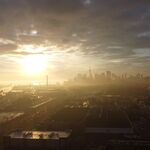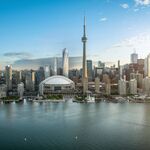The lure of Leslieville
Don't think I've seen this posted..
The Lure of Leslieville
By Dave McGinn, National Post
It is a prediction that has been making the rounds for years now: Eventually, Queen Street East will become the new Queen West. No one seems to know when this change will happen, and east-end residents are quite happy with the Queen Street they have, thank you very much. But with several condominium and loft projects either completed or currently underway, there is no doubt that Queen East is on the verge of a radical transformation.
“It has the potential to be better than Queen Street West,†says Brad Lamb, president of Brad J. Lamb Realty Inc. and Lamb Development Corp.
Both companies are playing a major role in the development of Queen East, especially in Leslieville.
However, these projects aren’t likely to radically alter the landscape of Queen East in the way condominium developments are poised to drastically change Queen West in the area near Gladstone Avenue. Thanks to zoning restrictions, condo projects in Leslieville can’t exceed nine storeys.
Most of the projects that have recently been completed in the area barely rise above the tree canopy, and the majority stand at least a block north or south of Queen Street.
Nor have the condo developments on Queen East precipitated any outcry to match Leslieville’s resistance to a proposal to build a big-box retail plaza, including a Wal-Mart, on the Toronto Film Studios site. While many storefronts in Leslieville display a poster reading “No Big Box in Leslieville,†there is no such similar opposition to condo and loft development.
And condo development is well underway. Relatively cheaper land in Leslieville has lured developers hoping to capitalize on its up-and-coming status. The Broadview Lofts, Queen City Vinegar Co. Lofts and several small-scale infill projects have all been completed in the past several years.
“Now that we’ve proven Queen East, we have the biggest developers calling and saying, ‘We’re interested in buying some land in Leslieville. We want to get a big site in Leslieville, do a few hundred units.’ I’m like, ‘Get in line now, guys,’ †Mr. Lamb says.
Indeed, the boom shows no sign of stopping. As industry has moved out or city council has rezoned it out of the area, condo developers market their projects with nods to the workplaces that once employed the locals. New condos include The Leslieville Lofts, Edge Lofts, Work Lofts, Printing Factory, Garment Factory and the Flat Iron Lofts.
Mr. Lamb estimates these projects, as well as those likely to begin in the near future, will see 4, 000 new residents just in and around the intersection of Queen Street East and Carlaw Avenue within five years.
That many new people in the area — most of them young professionals — will surely drive gentrification, Mr. Lamb says.
“What condominiums do is they add to the number of bodies on the street, which adds to the number of visits to the door of your retail environment,†he says.
Matthew Taylor, co-owner of Mercury Espresso Bar in Leslieville, a sunny spot with mismatched furniture and powerful coffee, welcomes the influx of people to the neighbourhood.
“It can only be good for business,†he says. “Most of the people who are moving here are moving here because they like the neighbourhood. It’s all about the local business.â€
Still, he says, over-gentrification could be a concern for businesses in Leslieville.
“I have a niche market, and it’s not really going to be affected by places like the Gap or H&M, or any of those other kind of places that could end up here. But at the same time, I don’t want to see that here either. I like the idea of Leslieville being that independent-business neighbourhood.â€
The gentrification has already begun.
Walk down Queen Street east of Broadview Avenue and there are signs of gentrification everywhere: new bars such as Rasputin, The Comrade, Pic Nic Wine Bar and Prohibition, and new restaurants such as Table 18 and Soma. All are recent Leslieville additions.
But there are plenty of boarded-up storefronts to be seen as well, and the neighbourhood has a quiet feel to it that is more Saturday afternoon than Saturday night.
Yet condominium development is often a driving force of gentrification, says Robert Levit, director of the Master of Urban Design program at the University of Toronto’s Daniels Faculty of Architecture, Landscape and Design.
“If you take the model of certain other neighbourhoods, like the changes in King West and around Niagara Street, it seems that it is in fact the condos that are driving the transformation of the area,†he says.
Developers say they don’t want to see their projects overwhelm Queen East.
“Our buildings push the community as your amenity,†says Alie Warren, vice-president of sales and marketing for Streetcar Developments, builders of Edge Lofts, a six-storey building with 66 units just east of the Don River.
“We don’t have swimming pools and lounges and all of that. Keeping it in the community and really drawing people into the area we’re developing is really important.â€
Yet while developers push Queen East as a hot new up-and-coming neighbourhood, the area remains a tougher sell than its west-end counterpart.
“In the collective unconscious of the residents of Toronto, it’s still a lesser-valued, not-as-good area as the west side,†says Yossi Kaplan, a real estate agent who specializes in downtown condos and lofts.
However, the development of the West Don Lands — 10 hectares of parks and 6,000 units of housing on the edge of Leslieville — will greatly improve the appeal of the area in homebuyers’ eyes, Mr. Levit says.
“Instead of having a post-industrial wasteland between downtown and the new Queen East developments, you’re actually going to have some remarkable amenities,†he says.
Mr. Lamb says Queen East’s relaxed vibe makes it an attractive proposition.
“What’s going to happen on Queen Street East, it’s inevitable: The Gapâs going to be on Queen Street East in 10 years,†Mr. Lamb says. “But that’s all part of the gentrification of an area that is of lower income and lower value right now.â€





